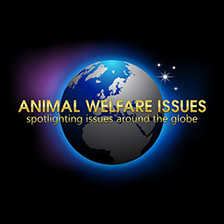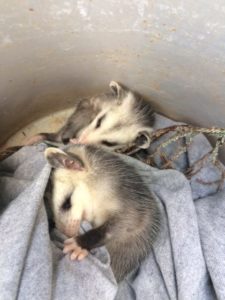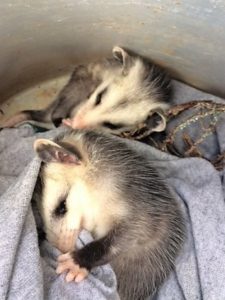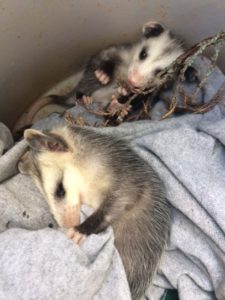It is the peak of springtime wildlife babies being born. According to RedCreek Wildlife Center, a rehab rescue for wildlife in Pennsylvania, they took in over 100 wildlife babies two weekends ago! That’s a lot of wildlife!
I’m accustomed to seeing baby rabbits, birds, kittens, squirrels, and even baby turkeys in my back yard but we’ve never seen baby opossums wandering in our yard with their actions indicating they didn’t know they were ready to walk directly into our pond. They had to be saved.
What started with my ever-so-curious dog, Brody, snooping around and crawling deep into one of your hedges, ended up with my husband finding two baby opossums wandering aimlessly and in danger of harming themselves.
After searching for the mother and other babies for many hours, we were unsuccessful to find more of them.
Did you know once a baby opossum is no longer attached to its mother, the mom will never return for them? It doesn’t matter if the babies eyes aren’t opened. The mother opossum wants nothing to do with a baby who is not latched to her or in her pouch. Opossums don’t leave their mothers voluntarily until they weigh at least 1/2 lb. They also don’t leave until they are at least seven inches long from head to rump not including the tail. These opossum didn’t measure that long.
Did you also know the mother typically gives birth to 13+ babies? That’s why it was surprising not to find other babies on or around our property or in our neighborhood. Our neighbor who lives down the street from us said he had opossum babies in his yard last year but none this year.
My husband saw two adult opossums the week prior to this outside of our yard in our grassy alley which is never used for traffic. Could one of them have been the mother? We’ll never know because we haven’t seen either one since that time. It’s possible the mother was killed and the babies were on their own. Purely conjecture on my part.
So what do you exactly do once you’ve found opossum babies? Remember they are wildlife and not puppies or kittens. You need to call a wildlife rehabilitator ASAP! No matter how old they are, they can give you information pertinent to your situation.
That’s what we did. Prior to the call, we wrapped the two babies in a sweatshirt which is vital to keeping their bodies warm. The rehab center can tell you if the babies are old enough to survive on their own.
It is best to handle baby wildlife as little as possible. You don’t want to stress them out anymore than they already are. They can easily die from too much handling by an inexperienced person. Prepare a container. A wildlife rehab center wants you to keep wildlife safe and in most cases, kept in in its natural habitat, if possible. However, when that isn’t the case, a wildlife rescue is the answer.
Off to Red Creek Wildlife Rescue we went. Contacting a wildlife rehab center is the most essential move you can make for them. We felt it was in these two adorable babies’ best interests for survival to be taken to the wildlife rehabilitator. The staff has the credentials, the knowledge, and experience to help them survive and thrive. By the way, don’t use your GPS for Red Creek, it will take you to a different location. Go to their website for directions. 🙂
Our baby opossums snuggled and slept in the container the entire time for the one hour trip. Opossums can be escape artists but these two were not of that mindset.
Wildlife rehab centers know what and when to feed baby wildlife. I feel taking them gives them the best chance at life. It’s illegal to keep baby opossums unless you’re a certified wildlife rehabilitator.
Did you know opossums may appear “dead?” Before disposing of the “dead” animal you’ll want to make sure the animal isn’t “playing possum/dead.” I’ve seen this phenomenon up close. If they feel threatened, the opossum will fall over and visibly look dead. What they’re doing is an involuntary reaction to a perceived danger to them. This “playing dead” can last anywhere from 40 minutes to 4 hours as they go into a comatose state. The animal will appear dead with its stiff body, glazed over eyes and lying on its side. They may drool and a green fluid coming out of their rectum certainly can convince someone the animal has died.
I watched an opossum fall over “dead” on its side and was stiff as can be. It was 30 minutes later when I watched it get up and walk away. He felt the threat was gone. This defense mechanism helps the opossum to survive a predator’s attack.
You can tell the opossum is beginning to recover from “playing dead” when its ears move so very slightly.

‘Tis the season for baby wildlife. The best thing you can do is call the wildlife specialists in your area.
Tina Evangelista-Eppenstein is a television talk show host, speaker, writer and is an unabashed animal advocate . Her love for animals is what drives her to promote awareness of the many issues facing animals. She hosts the show, ” A Close-Up Look at Animal Welfare Issues.” If you’d like Tina to talk to your group or have a story, please email her at tevangelistaepp@yahoo.com. Like https://www.facebook.com/ACloseUpLookAtAnimalWelfareIssues and check out AnimalWelfareIssues.com for all the tv shows, articles, and podcasts you may have missed!




I wish more people would take baby wildlife to wildlife rehabilitators. Too many think they can take care of them. Due to a lack of knowledge and experience the babies end up dying. I think it’s better to leave them alone except or some cases.
Red Creek is the best wildlife sanctuary. ?
I mean wildlife rescue.
Did you know once a baby opossum is no longer attached to its mother, the mom will never return for them? It doesn’t matter if the babies eyes aren’t opened. The mother opossum wants nothing to do with a baby who is not latched to her or in her pouch.
I didn’t know that. I wonder why the mom won’t come back for her babies. That seems cold. Poor babies.
Baby fawns will be born soon. Moms put them in a safe place where they can be disguised and fit right in their surroundings. If you find a fawn, the mother is very likely to be close by. Don’t pick up the fawn or remove it. Doing saw can do more harm to the fawn than good. The mother will come back unless you see that she’s dead nearby.
Always call for help!
I’ve read this post and if I could
I wish to suggest you few interesting things or tips. Make sure the wildlife rehab rescue is a legit place and not a person wanting to help wildlife. Ask for their certification papers. Be careful what other people tell you. If they’re not an expert they can steer you wrong. Perhaps you could write next articles referring to this article.
I want to read even more things about wildlife!
I agree with Roberta. They’re too many people pretending to be animal rescuers when they’re only people taking in animals and don’t have the qualifications nor expertise to help wildlife.
Contact your local animal shelter and ask for a referral to a wildlife rehabilitator. If you call animal control make sure they don’t euthanize them. The game commission is known to do this. Many places such as shelters and animal control don’t have the resources to take care of wildlife, baby or adults. Seek out the pros.
Take the baby to a wildlife rehab to be on the safe side if you don’t know what you’re doing. At the very least, call them and ask what you should do.
If you are unsure how to proceed when you find a baby animal, it is always best to contact a wildlife rehabilitator BEFORE moving the animal.
I found a baby opossum wandering around aimlessly this morning. I was able to pick her up easily. I wonder if she is blind. I took her to Busch Wildlife Sanctuary in Florida and they gave me a patient number so I can call and get updates on her. She will now be protected for the rest of her life. She tried to get out of the shoebox I had her in (it had big holes) and I was afraid she was dead when we arrived. But she was just sleeping.